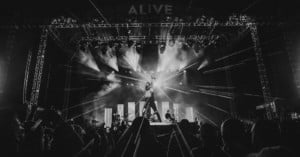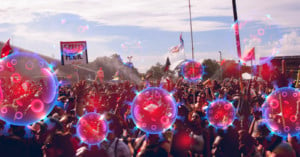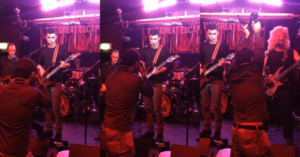
Photographer Fined For Almost Flying Drone into Fatboy Slim at Concert
A photographer was fined over $1,100 (£891) after he almost crashed a drone into Fatboy Slim as the DJ performed at a concert in front of thousands of people.

A photographer was fined over $1,100 (£891) after he almost crashed a drone into Fatboy Slim as the DJ performed at a concert in front of thousands of people.

Like most photographers, I’ve never reviewed a piece of gear before. Also like most photographers, I tend to voraciously read reviews each time I consider upgrading. Many of these reviews parse through micro-level analysis of pixel detail, noise levels, and test charts but to me fail to answer the simple question: “will this help me get the shot?”

A camerawoman, who claims Marilyn Manson caused her “fear and anxiety” after he spit and blew his nose on her at a concert, has revived her lawsuit against him.

Marilyn Manson has been sentenced in court after he pleaded no contest to spitting on and blowing his nose on a videographer during one of his concerts in New Hampshire.

One of the most exciting things to photograph is a live concert. Rock concerts in particular have an air of electricity about them that you can feel. When you are hired to photograph one you automatically feel like you are a part of that excitement.

Photographer David Bergman has been a concert tour photographer for more than 30 years and shares his tips for making continually unique and engaging photos through a multi-city stadium concert tour.

Shooting from a photo pit or area is an important part of photography niches such as concert and sports photography, but how do you get access in the first place? This is not an easy task but with a little work and dedication, you can position yourself to be allowed in this coveted area.

Live music photography (also known as concert photography) is one of the most exciting and gratifying genres of photography. Granted, it’s not for everyone and it requires a lot of work in not-so-ideal conditions. However, if you're up for a challenge, you could find it rewarding and capture some rather unique and interesting shots. But behind every shot from the pit, there are some basic standards and sometimes unwritten codes of conduct that every photographer should adhere to.

As a 20-year old concert photographer, one of the questions that I get the most is: “How did you manage to land a touring job so quickly and at a young age?” Here are a few tips that I used when navigating my way into the concert photography industry.

Live music and the resumption of public schools have become a flashpoint (1, 2) in the battle about masks and vaccines in the public sector. My son is homeschooled so I cannot speak to that, but I can speak about live music.

Event photography is an art form, and it takes a while to achieve what you’re looking for. Not only does shooting an event require you to be constantly on the move, but it’s also necessary to know how to fully use each setting on your camera.

I'm often told that being a professional concert photographer is the coolest job in the world. In order to dispel some myths surrounding what I do and also support others who want to get into the profession, I’m going to peel back the curtain of the entire process from preparation to editing.

Before I picked up a camera and discovered the potential for documentation, I had (still have) a first love: being a bass player. For those not in the know, the bass is the instrument that isn’t the guitar, isn’t the drum kit, and isn’t the vocals.

Rolling Stone's first staff photographer Baron Wolman has passed away at the age of 83. Though known primarily for his work with the rock magazine where he captured some of Rock's most iconic imagery, Wolman's photography career was vast and varied.

In Summer of 2019, while working with Elbow in Manchester, concert photographer Peter Neill had an idea. He decided to try and stitch an epic panorama... with a twist. Instead of using a wide-angle, he would use an 85mm f/1.4 and capture a pano of the stage and the crowd, but with a shallow depth of field and bokeh.

Dear Live Nation,
This is an open letter to your company regarding the increasingly poor treatment of media and credentialed photographers.

I’m an experienced concert photographer. From the largest stadiums to the smallest, dirtiest night clubs, I’ve photographed thousands of bands and seen it all. I’m damned confident in my ability to anticipate the shot and be in the right place at the right time. Or, at least I was until last Saturday night.

I am writing this concert photography guide in response to several ‘How to’ guides I have seen online that don’t quite hit the mark on how to take great live concert photographs. Most of the articles focus too much on the obvious, like concerts are dark and avoid things in your way (like mic stands and such). Personally, I think it is a bit patronizing to suggest that you are letting the photographer in on the ‘professional secrets’ if it is written by a non-professional music photographer, so this is my guide.

American music star Ariana Grande has sparked an outcry from photographers and media organizations with her new concert tour agreement. Reportedly a response to "greedy photographers" taking advantage of her in the past, the new contract requires that photographers hand over full copyright to their photos.

What would it look like if I made a timelapse out of every single picture that I captured during a concert? I had occasionally been toying with this idea since I saw a wedding timelapse by photographer Kevin Mullins a while ago.

Concert photographer Rich Gastwirt came up with this unusual "viral" business card for getting his website URL into people's hands.

A popular music festival is offering a new "fan experience" that's raising eyebrows among some photographers: pay $500, and you'll have the opportunity to shoot concert photos for the festival from the photo pit.

This guide is intended for concert photography beginners. If you have a DSLR camera and are interested in how to control your camera settings to take great photos at concerts, this guide is for you. If you're an experienced photographer who just hasn't shot shows before, there may be some helpful info in here along with plenty of stuff you know already.

Red Hot Chili Peppers guitarist Josh Klinghoffer hates when people at the band's shows spend the whole time staring through their screen—shooting the performance on a 4-inch box instead of experiencing it for themselves. So last year, during a show in Turin, Italy, he turned the tables.

Musician Ryan Adams got into another very public scuffle with a photographer this week. Midway through his set at the 2017 Gasparilla Music Festival, Adams, who suffers from Meniere’s disease, called out photographer Joe Sale for using flash photography and potentially putting the musician's health at risk.

There are a lot more music photographers than there are music photography jobs — that’s just how it is in this corner of the industry. It's a port of entry for many hobbyist photographers, and the result is saturation of the market. A lot of budding photographers are willing to work for free, making the gigs that are out there even tougher to get.

It’s been a big week for Nikon announcements at CES 2016 in Las Vegas, with launches of the Nikon D500, Nikon D5, and new SB-5000 Speedlight. The new D500 is a camera that many people have been waiting a long time for — a successor to the Nikon D300/D300s and a true flagship for the Nikon DX line of APS-C cameras. The D500 packs in many of the same new, next-generation features as the Nikon D5 that was also just announced, including a brilliant new autofocus system, EXPEED 5 image processing, and a whole lot more.
With the Nikon D500 now official, I am extremely excited to say I had the privilege of shooting with the D500 to create images for its launch. I’ve had to keep this project under wraps since August, but now that the camera has been announced, I can finally share my thoughts on this new DX flagship DSLR.

Restrictive concert photography contracts have been a big story in the photo world over the past several months. Taylor Swift, the Foo Fighters, Dweezil Zappa, and Janet Jackson have all made headlines for their extremely strict -- and often rights-grabbing -- contracts that photographers and reporters must sign before covering a concert.
Now a number of the media industry's biggest associations and organizations have published an open letter to performers on behalf of thousands of photographers and journalists in the United States.

There's a revolution brewing in the world of concert photography. After photographer Jason Sheldon penned a viral open letter to speak out against Taylor Swift's concert photo contract, a major Irish newspaper decided to boycott photos at Swift's recent concert. Now a Washington newspaper has followed suit with another major player in the music industry: the Foo Fighters.
The Washington City Paper says it won't be sending a photographer to this weekend's Foo Fighter concert due to the fact that the band's contract "sucks." Instead, the paper hopes to buy photos directly from fans who attend the show.

After my public response to Taylor Swift’s open letter to Apple, I didn’t quite expect the phenomenal reaction it received. I knew it was provocative. I knew it was going to be risky and could possibly harm my chances of getting access to other concerts in future, but it needed to be said -- out loud. When I thought hard about the possible consequences, and restrictions on my access to future work, I asked myself “What point is there in going to work if I can’t be paid for it, yet everyone else gets to benefit from my labor?”. The answer?
There was nothing left to lose. When you’re faced with a choice of working for free to save a millionaire having to pay a reasonable fee, or not working at all, what would you do?

Yesterday, photographer Jason Sheldon published an open letter to Taylor Swift, accusing the singer of being a hypocrite by accusing Apple of treating artists unfairly while herself handing out heavy-handed contracts for concert photographers to sign.
It turns out Sheldon's contract was a bit outdated: the latest version goes a step further by stating that photographers who violate the contract can have their gear destroyed on the spot.

Vintage Trouble recently played their biggest gig in front of 115,000 people as the support act of AC/DCs “Rock or Bust” Tour 2015 at the Red Bull Ring in Zeltweg, Austria.
I had the once in a lifetime opportunity to join the band and work with them directly on stage. It was life changing for me and this experience once again showed me that being a concert photographer is the best job in the world!

Editor's note: This video contains NSFW language
It's easy to assume that the whole 'no flash photography' rule at concerts is ignorable, but as the clip above shows, not only can it distract the performer, in some rare cases it might actually be a health hazard.

We've heard of musicians prohibiting photography and video at their shows, we've even seen video of musicians publicly shaming fans who refused to experience the show through anything other than a 4-inch screen, but iconic guitarist Peter Frampton took smartphone photography intolerance to an epic new level this past weekend.

A couple of days ago, we received an email from a concerned concert photographer who had apparently earned the right to photograph an upcoming Motely Crüe concert.
The photographer, who preferred not to identify him or herself, shared with us what they claimed to be the Red White & Crüe Inc. photography licensing agreement, bringing our attention to wording that seems to indicate photographers can't even license their own images without the company's express consent.

Choosing the right camera settings for concert photography can be a daunting task, even for experienced music photographers. Here’s a breakdown of every major camera setting that I recommend for shooting live music.

A few months back I got to see the mighty, ever-reigning dinosaur kings of rock, the Rolling Stones. I had a general admission ticket and a small pocket camera, and arrived many hours early so as to worm my way clear up to the front.

The above video, titled "How not to be a photographer at a gig," has gotten a ton of attention over the past few days as it has made the rounds online. It shows concert photographer Aelle Lucà at a small gig really going at it with the flash and bothering (at the very least) the person who recorded and posted the video.
As you might imagine, the comments section for this video on YouTube quickly turned into a troll-fest of insults and negativity directed at Lucà. But as it turns out, this is exactly what the band wanted and asked for... and his photos turned out pretty darn well.

Have you ever heard of the "4 Seconds" myth in concert photography? Well, probably not, because I made this phenomenon up as a play on words with the 4 Leaf Clover "Myth." The 4 Seconds Myth talks about the fact that there’s a maximum period of time at just a few concerts when you can in fact shoot at crisp, noiseless ISO 100.

Let me start by stating that I’ve been a fan of Montreal’s Slaves on Dope since the mid to late 1990s. Does that make a difference in the relevance of the rest of this blog entry? Nope. Just felt like saying that.
I’ve had the chance to shoot them a few times live and they are always fun to see…. and ever better to shoot! They were playing at the Heavy MTL festival this past August, early on the second day, and I made my way to the small stage to grab a few shots.